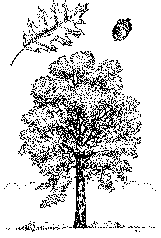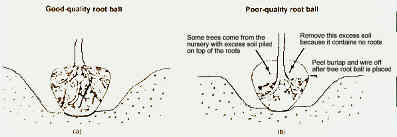

northern red oak
Quercus rubra
Northern red oak is a valuable tree for both your landscape and for its timber. An deciduous tree with a mature height of 60 to 90 feet and 60 to 75 feet wide. An excellent, large tree for shade, and wildlife habitat. Appropriate for medium to large yards and parks, this strong wooded specie will add variety to your landscape. In heavy crop years, the acorns can become slightly messy as squirrels cannot keep up. The cultivar ‘Splendens’ is known for it´s red fall color.
Native Range:

Plant illustration by Dale Larison, Missouri Department of Conservation
Range map modified from USDA Forest Service Silvics of North America Web site - www.na.fs.fed.us/spfo/pubs
/silvics_manual
/table_of_contents.htm
Super Product
I have a product that provides sound buffers, reduces utility bills, reduces use of fossil fuels, reduces flooding, produces a sense of community, cools the air, cleans the air, beautifies surroundings, increases property values, ameliorates global warming, reduces and prevents soil erosion, freshens the atmosphere, provides wildlife habitat, provides privacy, directs traffic, prevents and reduces water pollution, recharges groundwater and sustains stream flow, supplies building materials, increases crop yields, provides food, controls snow deposition, creates oxygen, provides medicine, slows floodwaters, and provides shade.
Interested in such a product? It is a tree. Properly planted and placed, trees provide all of these benefits. Many of which have documented dollar values. Improve your community, plant a tree in your yard, along the street, in a park, along a stream, or some other appropriate place. You and your community will reap the rewards.
Not Too Deep, Please
Recent research has exposed a problem with tree planting techniques used over the last several decades. Planting trees too deep is this problem. Solving this problem is the responsibility of everyone that handles a tree destine for planting in the landscape from the propagator to the planter. Unfortunately, I also have planted trees too deep in the past.
|
You can make a major improvement in a trees´ life by locating the root flare on the trunk. Many times these are buried in the root ball. Remove all of the soil above the root flare. Once you have exposed the root flare, dig your planting hole so the root flare will sit on top of the ground or slightly above.
Learn more about stem girdling roots by visiting www.extension.umn.edu/distribution/naturalresources/DD7501.html.
TRIM - Tree Resource Improvement and Maintenance Grant
TRIM is an MDC cost-share grant program designed to improve the public tree resource. Various activities are eligible for this grant and may include: tree ordinance development and establishment, community tree management plan, community tree inventories (hazard, street), training city employees and volunteers, purchasing tree education materials, initial ISA certification costs, development and distribution of tree care education materials (pamphlets, PSA´s, billboards, etc.), hazard tree removal, pruning to ANSI A300 standards, tree planting, and anything you can think of that is directly related to trees that will benefit your community.
All units of government, public schools, and non-profit groups with appropriate permission may apply for projects. All projects must be on or relate to public property.
Applications will be mailed in late March to communities directly from the MDC state office. I will also have a small supply after the mailing occurs. All applications must be reviewed by me (Jon Skinner) or another MDC forester by May 14 with signature documenting such. Completed applications must be postmark and sent to Justine Gartner in the MDC State office by June 1, 2004.
If you have questions, contact Jon Skinner (Jon.Skinner@mdc.mo.gov) at 417-629-3423.
Is Your Information Correct?
Spring is a time of renewal. It is also time for me to ask if I have your contact information correct. Below is a sticker with your name and other contact information. Please review it for accuracy and contact me with any corrections.
The information that is helpful for me to be able to contact you is: Your name, organization title, organization name, work, fax, cell, home, and alternative phone numbers, address - street and PO box, City, State, Zipcode, and email address.
Corrections may be sent to:
Jon Skinner
Urban Forester
Missouri Dept of Conservation
705 Illinois Ave., Ste. 6B
Joplin, MO 64801-5065
417-629-3423
Fax: 417-629-3426
Jon.Skinner@mdc.mo.gov
 Image modified from
Image modified from